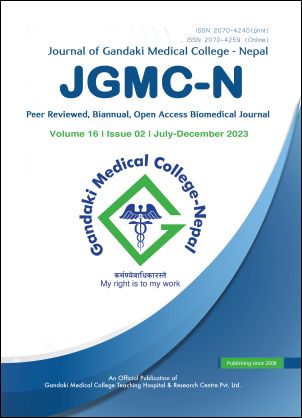Evaluation of the relationship between the interpupillary distance and mesiodistal width of maxillary anterior teeth in Nepalese population
DOI:
https://doi.org/10.3126/jgmcn.v16i2.59393Keywords:
Inter-pupillary distance, mesiodistal width, Central incisor, anterior teethAbstract
Introduction: For pleasing aesthetic appearance, the maxillary anterior teeth must be in proportion to facial morphology. Among the different facial measurements used to determine mesiodistal width of maxillary anterior teeth, the interpupillary distance remains constant irrespective of age changes. The objective of this study was to determine the relationship between the inter-pupillary width and mesiodistal width of maxillary anterior teeth.
Methods: This was a hospital-based cross sectional study conducted at outpatient department of College of Dental Surgery, Gandaki Medical College, Pokhara, Nepal. The study comprised of 199 participants of age group 18 to 35 years. The inter-pupillary distance and mesiodistal width from maxillary right canine to left canine (R3L3) were measured with a digital vernier caliper (Aero-space company, India) with accuracy of 0.01mm. Independent t-test was used to compare inter-pupillary distance and R3L3 between males and females while Pearson correlation was used to see the inter-relationship between these two parameters. Regression analysis was used to predict the mesiodistal width of right central incisor and R3L3.
Results: The overall IPD was 66.09 + 4.00 mm and R3L3 was 54.27 ± 4.47 mm. There were no significant differences in IPD and R3L3 in males and females. The IPD and R3L3 showed moderate positive correlation, r=0.47, p-value <0.001.Prediction equation was calculated to predict the R3L3 and mesiodistal width of right central incisors.
Conclusions: There was a positive correlation between inter-pupillary distance and mesiodistal width of maxillary six anterior teeth. Prediction equation will be useful to determine the mesiodistal width of the maxillary six anterior teeth based on interpupillary distance.
Downloads
Downloads
Published
How to Cite
Issue
Section
License
Copyright (c) 2023 Sapna Laxmi Tuladhar, Pratik Manandhar, Neeta Thapa, Dilesh Pradhan, Umesh Parajuli

This work is licensed under a Creative Commons Attribution-NonCommercial 4.0 International License.
This license allows reusers to distribute, remix, adapt, and build upon the material in any medium or format for noncommercial purposes only, and only so long as attribution is given to the creator.




